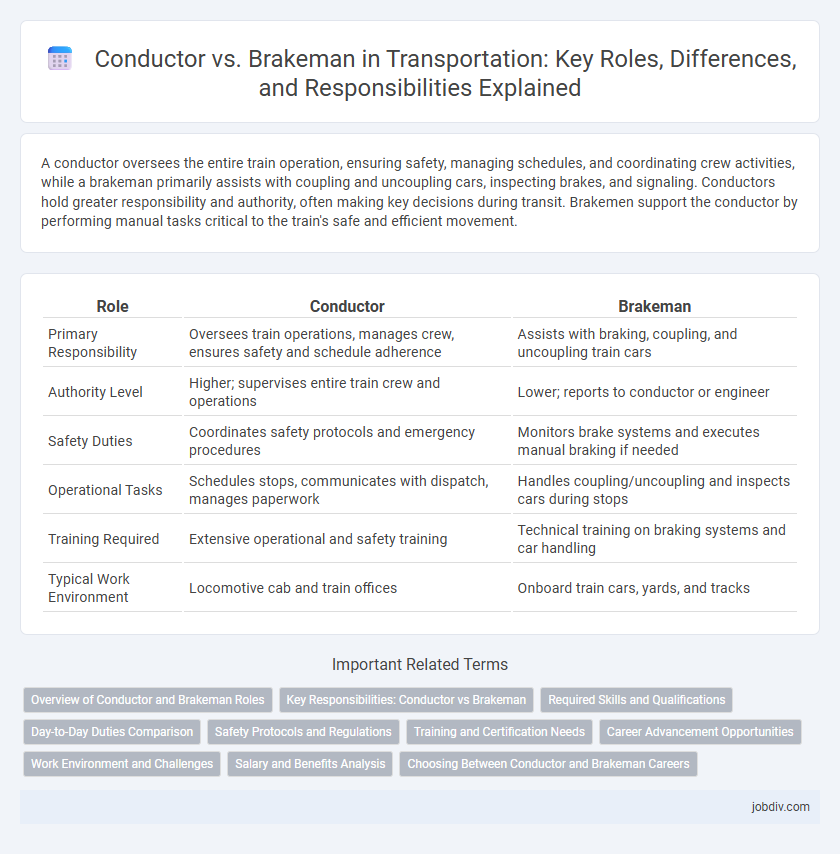A conductor oversees the entire train operation, ensuring safety, managing schedules, and coordinating crew activities, while a brakeman primarily assists with coupling and uncoupling cars, inspecting brakes, and signaling. Conductors hold greater responsibility and authority, often making key decisions during transit. Brakemen support the conductor by performing manual tasks critical to the train's safe and efficient movement.
Table of Comparison
| Role | Conductor | Brakeman |
|---|---|---|
| Primary Responsibility | Oversees train operations, manages crew, ensures safety and schedule adherence | Assists with braking, coupling, and uncoupling train cars |
| Authority Level | Higher; supervises entire train crew and operations | Lower; reports to conductor or engineer |
| Safety Duties | Coordinates safety protocols and emergency procedures | Monitors brake systems and executes manual braking if needed |
| Operational Tasks | Schedules stops, communicates with dispatch, manages paperwork | Handles coupling/uncoupling and inspects cars during stops |
| Training Required | Extensive operational and safety training | Technical training on braking systems and car handling |
| Typical Work Environment | Locomotive cab and train offices | Onboard train cars, yards, and tracks |
Overview of Conductor and Brakeman Roles
The conductor supervises train operations, ensuring safety, coordinating crew activities, and managing schedules, while the brakeman assists with coupling and uncoupling cars, applying brakes, and inspecting equipment. Conductors hold overall responsibility for train movement and communication with dispatch, whereas brakemen focus on manual tasks essential to train handling and yard operations. Both roles demand knowledge of railroad safety protocols and teamwork for efficient train management.
Key Responsibilities: Conductor vs Brakeman
The conductor oversees the entire train operation, coordinating crew activities, managing schedules, and ensuring passenger safety, while the brakeman primarily handles the manual application of brakes, inspects equipment, and maintains communication between train cars. Conductors are responsible for dispatching, managing cargo, and enforcing regulations, whereas brakemen focus on track switching, coupling and uncoupling cars, and monitoring train stability during transit. Both roles are critical for efficient train operations, emphasizing safety, coordination, and mechanical oversight within rail transportation.
Required Skills and Qualifications
Conductors require strong leadership, communication, and problem-solving skills to manage train operations, ensure passenger safety, and coordinate crew activities. Brakemen need physical stamina, attention to detail, and mechanical aptitude to handle coupling, inspect brakes, and perform manual switching tasks. Both positions demand knowledge of railway safety regulations and the ability to work in diverse weather conditions.
Day-to-Day Duties Comparison
Conductors oversee train operations, ensuring schedule adherence, passenger safety, and communication with dispatchers. Brakemen assist with coupling and uncoupling cars, monitor train integrity, and handle switching duties in yards. Both roles require teamwork and safety vigilance, but conductors primarily manage train movement while brakemen support mechanical and operational tasks.
Safety Protocols and Regulations
Safety protocols for conductors emphasize passenger management, emergency communication, and compliance with federal transportation regulations, ensuring smooth train operations and passenger security. Brakemen focus on track-side duties, including coupling and uncoupling cars, operating hand brakes, and inspecting equipment to prevent accidents and derailments under strict safety standards. Both roles require adherence to Occupational Safety and Health Administration (OSHA) guidelines and Federal Railroad Administration (FRA) regulations to minimize risks and maintain operational safety.
Training and Certification Needs
Conductors require extensive training in operational procedures, safety regulations, and communication protocols, often necessitating certification through organizations like the Federal Railroad Administration (FRA). Brakemen typically undergo specialized training focused on manual braking systems, coupling, and track switching, with certifications varying by region but generally less comprehensive than conductor requirements. Both roles demand rigorous safety training, but conductors face broader certification mandates due to their responsibility for overall train operations.
Career Advancement Opportunities
Conductors typically experience faster career advancement due to their leadership role in train operations, overseeing schedules, crew coordination, and safety compliance. Brakemen often begin in entry-level positions handling equipment and track switching but can progress to conductor roles through experience and additional certifications. Advancement opportunities hinge on acquiring specialized skills, such as signal operation and regulatory knowledge, which enhance prospects in the rail transportation industry.
Work Environment and Challenges
Conductors typically operate in control cabins or train stations, managing train schedules and passenger safety, facing challenges like tight time constraints and communication demands. Brakemen work primarily on the exterior of trains, often exposed to harsh weather and physical hazards while coupling cars and applying manual brakes. Both roles require vigilance and stamina, but conductors face more mental stress, whereas brakemen endure greater physical risks in their work environments.
Salary and Benefits Analysis
Conductors typically earn higher salaries than brakemen, with average annual wages ranging from $52,000 to $75,000 depending on experience and railroad company size. Brakemen salary averages are generally lower, around $40,000 to $55,000, reflecting their entry-level position and fewer responsibilities. Benefits for both roles often include health insurance, retirement plans, and paid time off, but conductors may receive enhanced benefits such as performance bonuses and seniority-based incentives.
Choosing Between Conductor and Brakeman Careers
Choosing between conductor and brakeman careers depends on specific job responsibilities and skill sets. Conductors oversee train operations, manage schedules, and ensure safety compliance, while brakemen focus on signaling, coupling, and track switching. Career advancement opportunities and certification requirements typically favor conductors, making them a preferred choice for long-term growth in the rail industry.
Conductor vs Brakeman Infographic

 jobdiv.com
jobdiv.com